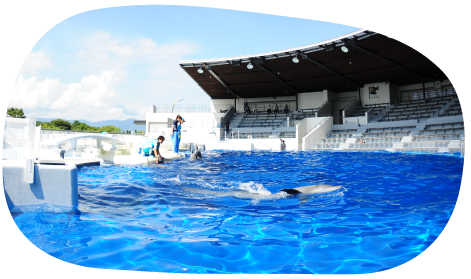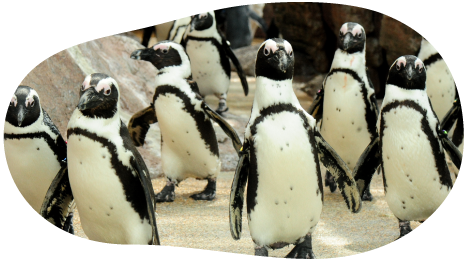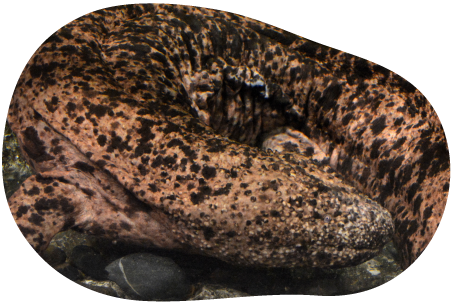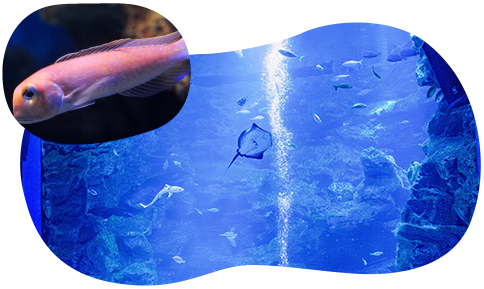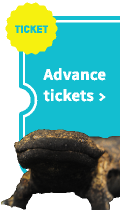Floor Guide
Floor
1F
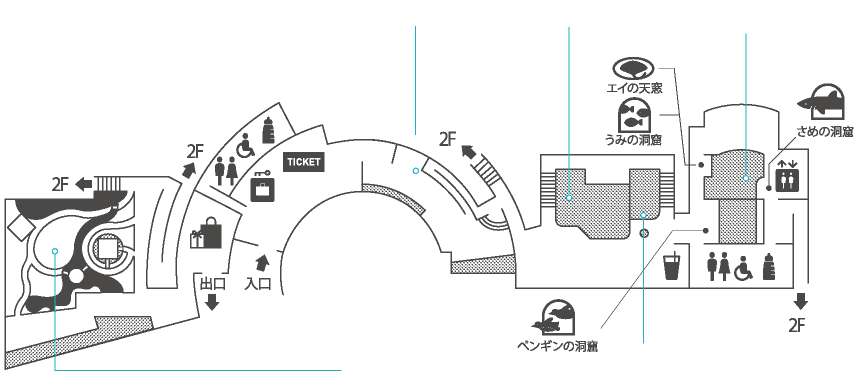
the River of Kyoto
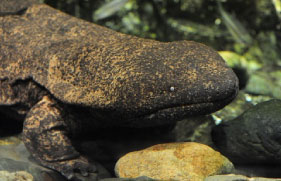
the River of Kyoto
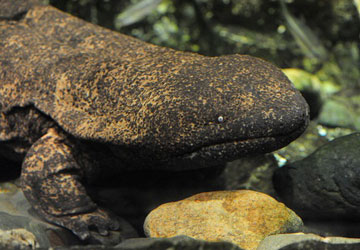
There, right before your eyes, is world’s largest amphibian, the giant salamander.
The giant salamander is a Special Natural Monument of Japan. Described as a living fossil and believed to be one of the world’s largest amphibians, there are many mysteries surrounding the ecology of this extremely rare animal. Kyoto Aquarium has a large-scale exhibit area with a realistic display of the giant salamander’s ecology in the rivers of Kyoto.
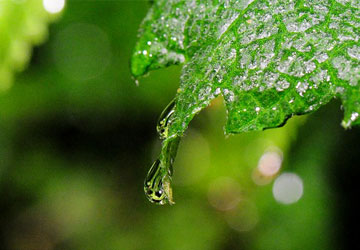
See the whole of the Yura River, from upstream to downstream, right here!
The Yura River’s upstream, midstream, and downstream ecosystems have all been expressed in a single pool. Char and landlocked masu salmon swim in the upstream section, striped shiner and Japanese minnow in the midstream section, and carp and other fish in the downstream section. Enjoy the creatures that live in the Yura River and the changes of the seasons.
Look closely
The giant salamander is a nocturnal creature, so lies still during the day. However, if you pay close attention, you might be lucky to spy its slow and measured motion as it moves to a different location or swims up to the surface to breathe.
Creatures encountered in this area
Giant salamanders, char, landlocked masu salmon, Japanese minnow, carp, etc.
Fur seal
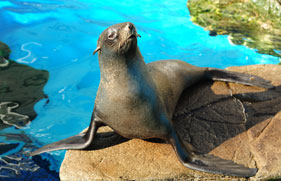
Fur seal
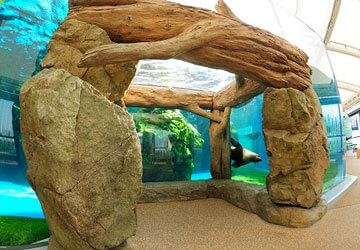
A pool that gives the illusion of swimming with fur seals
This horseshoe-shaped pool is the perfect size and height for small children. The space may feel a little cramped for adults with its low ceiling, but it is a delightful space for children, like being in a hideout. When entering the viewing area, visitors will experience the strange sensation that they are actually swimming with the fur seals. This exciting sensation is bound to pique your curiosity.
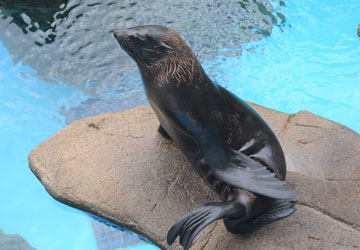
See the endearing sight of the fur seals sleeping in unique poses on the rocks.
From above the pool, visitors can see the fur seals lying on rocks and logs, basking in the sun and looking very relaxed, from a close distance. They will be so close that you will be able to see their big, bright eyes and every strand of their soft fur.
Look closely
The fur seals that live at Kyoto Aquarium have some truly unique and interesting poses when they sleep. Some of them curl up in a ball, others stretch their bodies back, and others balance precariously on logs. Check out their unique, endearing poses.
Creatures encountered in this area
South American fur seals
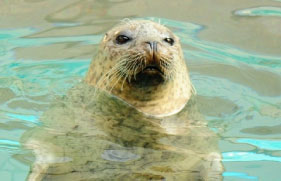
Seal
Seal
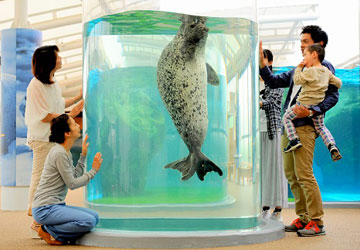
Get right up close to their unique expressions
An even more eye-catching sight is the large, tubular pool. This pool is actually connected to a larger tank under the floor, and the spotted seals are able to come and go freely between the two. When the seals pop up into the tubular pool, it looks just like they are flying through the air.
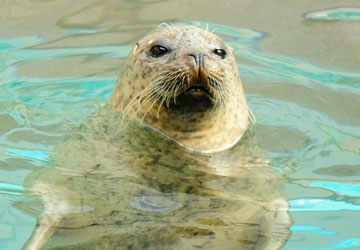
When they pop their faces up, you might even make eye contact.
From the deck, visitors can enjoy the unique expressions of the earless seals as they peep up from the surface of the water. If you are lucky, you might be able to gaze into the depths of their cut, round eyes.
Look closely
At certain times, visitors can also observe the earless seals being fed. Their expressions as they gaze up at the staff, begging for their food, are even cuter than usual.
Creatures encountered in this area
Spotted seal
the Sea of Kyoto
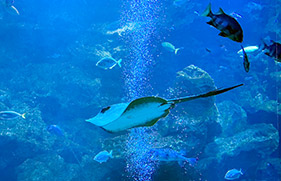
the Sea of Kyoto
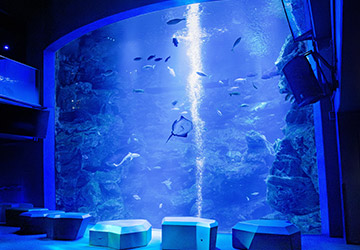
Experience the mysterious atmosphere of Kyoto Aquarium’s largest pool
The magnificent sight of many different varieties of aquatic life swimming gracefully around the huge pool, filled with about 500 tons of artificial seawater that recreates Kyoto’s sea, is a breathtaking one. The huge “Sea of Kyoto” pool has about 50 varieties of aquatic life living in it, for example Bulgyhead wrasse, members of the stingray and shark families and so on. Since the creatures seen in the sea of Kyoto are changing due to the climate change, we are regularly reviewing the variety of fish in the tank.
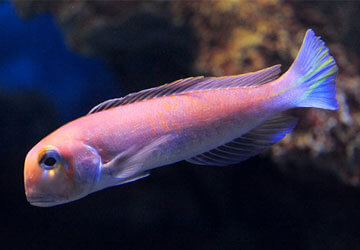
Meet the creatures that are part of Kyoto’s culinary culture
Amadai, or tilefish, are also referred to as guji and are considered a delicacy in Kyoto cuisine. Visitors can observe up close the ecology of red tilefish, with their beautiful, bright pink bodies, as they swim around the pool and mark their own territories where they live.
Look closely
The huge “Sea of Kyoto” pool has about 50 varieties of aquatic life living in it.
Draw right up close to the pool to see what kind of creatures you can find, or stand away from the pool and be soothed by the overall sight of the pool.
Creatures encountered in this area
members of the stingray and shark families, red sea bream, Bulgyhead wrasse etc.
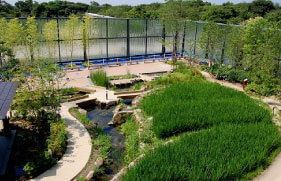
the Countryside of Kyoto
the Countryside of Kyoto
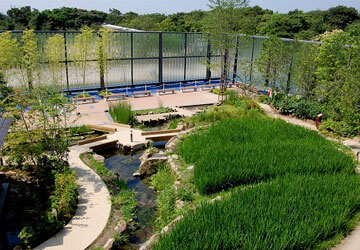
A rice paddy in the middle of an aquarium!? Experience first hand the connection between humans and living creatures on a natural stage
The Kyoto Satoyama area, which recreates the traditional rural scenery of Kyoto, grows rice, Kujo onions, Shogoin turnips, and other traditional Kyoto vegetables, depending on the season.
This outdoor area has such an abundance of natural scenery that you will forget you are so close to the big city. On fine days, it is the perfect spot for a stroll.
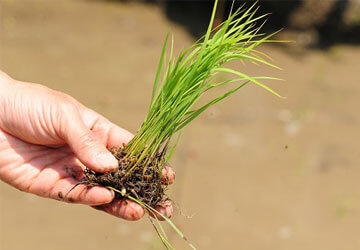
Experience the connections between living creatures, humans, and nature
When the water level in the canals increases and the rice paddies are flooded with water, the fish that use that water enter the rice paddies via the canals and lay their eggs. Feel that connection between people and living creatures.
Look closely
Different insects and birds also visit the Kyoto Satoyama Area in the different seasons. You can expect the unexpected in this outdoor area.
2F
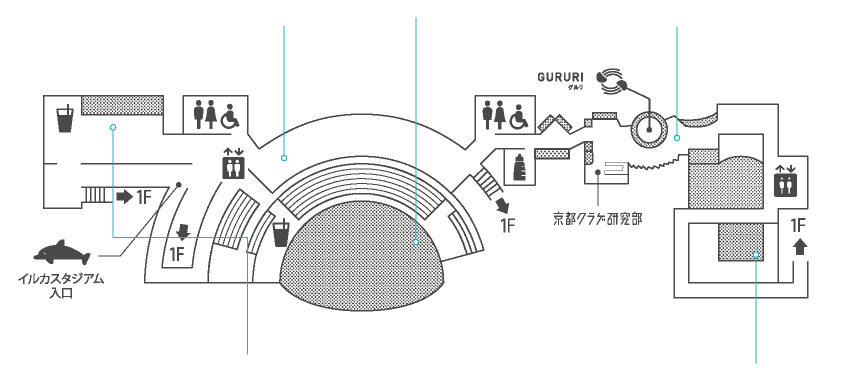
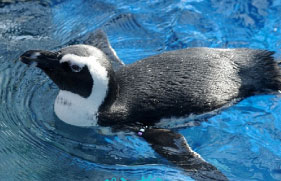
Penguin
Penguin
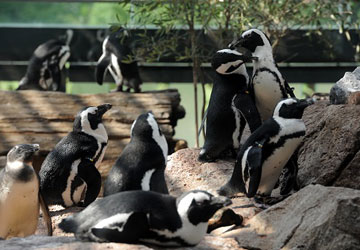
A star of the aquarium that moves leisurely on land and dynamically in the water
Most people think of penguins as living in cold climates like Antarctica, but the cape penguin actually lives in the warmer climes of southern Africa.
The land part of the penguin exhibit is undulated, making it difficult for the penguins in the water to climb the hills. This is, in fact, a deliberate design feature intended to facilitate the penguins’ development. Penguins use the power of the waves to propel themselves onto shore. The sight of the penguins displaying their wild behavior is not to be missed.
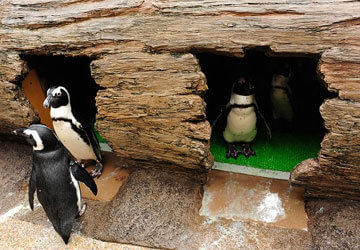
Making nesting holes to aid the penguins’ love life.
When breeding season arrives, Kyoto Aquarium makes nesting holes for the penguins. These holes actually play a very important role in making the penguins’ love bloom. It is primarily the job of the male penguin to make the nest. They make a magnificent nest and then they propose to the female. So they can present their mate with a bigger nest, the males collect pebbles and other materials from all over and build their nests quickly and efficiently.
Look closely
You can see what’s happening in the water from the 1st floor, and what’s happening on the hill from the 2nd floor. The gap between their toddling walk on land and the dynamic way they plunge through the water is irresistible.
Creatures encountered in this area
Cape Penguin
Jellyfish Wonders
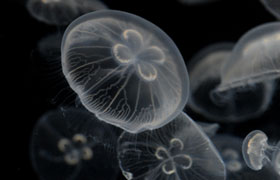
Jellyfish Wonders
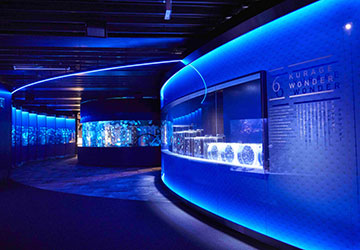
About 30 different species and 5,000 Jellyfish are exhibited.
Drifting through the water, staying on the bottom of the sea, poisonous…, Jellyfish that are different and unique in the characters, sizes and colors are exhibited in the various aquariums.
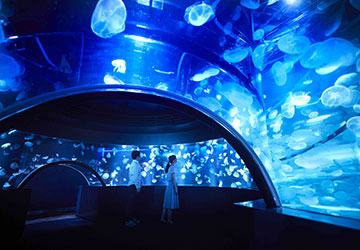
The GURURI aquarium, with a 360-degree Jellyfish drifting panorama
Passing under the arch of water tank, you will encounter a mysterious scenery of the full of moon jellyfish wandering in the water. Surrounded by the 360-degree aquarium, you will feel the impression of floating amongst a sea of jellyfish.
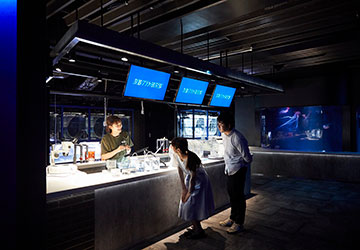
Kyoto Jellyfish Science Club
Welcome to our open-spaced laboratory that lively shows jellyfish breeding and research by the aquarium staff. You will closely observe how they attentively treat jellyfish every day.
Communication Hall
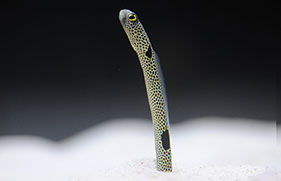
Communication Hall
Information base about Kyoto Aquarium
We exhibit coral lives permanetly, Garden eels, Anemone fish, and so on. We are also transmitting information about Kyoto Aquarium, for example, the "STAFF STATION", which is introducing our aquatic lives by aquarium keeper with full of LOVE, and reporting "AQTION!"- the Kyoto Aquarium's action to realize a sustainable society. In addition, you can enjoy various workshops.
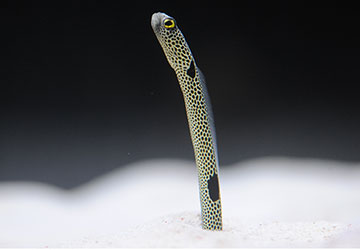
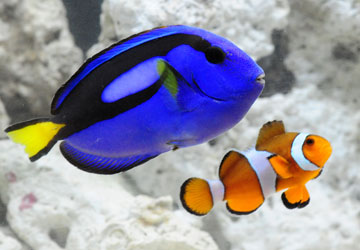
Colorful creatures living in the warm sea.
You will closely observe patterns, colors, and other characteristics of the colorful warm sea life, such as Garden eels swaying their bodies and 6 different kinds of Anemone fish that are seen in Japan.
Dolphin Stadium
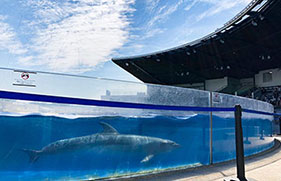
Dolphin Stadium
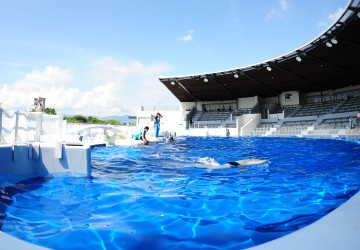
See the dolphins swimming leisurely at the stadium with views of the ancient capital
Feel the breath of the common bottlenose dolphins up close and watch their dynamic movement as they swim leisurely around. If you listen closely, you might even hear the dolphins calling out to each other.
You may see various scenes like the dolphins enjoying their meals and playing while they interactively communicate with the trainer.
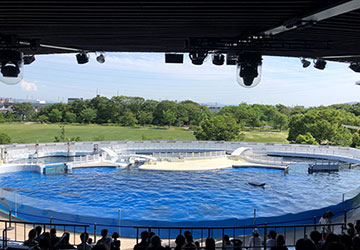
Natural scenery that changes with the seasons
The Dolphin Stadium is set against the backdrop of wide open, 180º panoramic views that change with the seasons. Appreciate the beautiful natural scenery that only Kyoto can offer - the cherry blossoms in spring, the new green leaves in summer, the colorful leaves of autumn, and the snow-covered landscape in winter.
Look closely
Common bottlenose dolphins are very curious creatures. If you approach the side of the pool, sometimes, they will show interest and come up to you.
Creatures encountered in this area
bottlenose dolphins
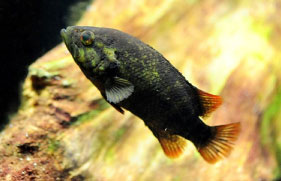
the Beauty of Nature
the Beauty of Nature
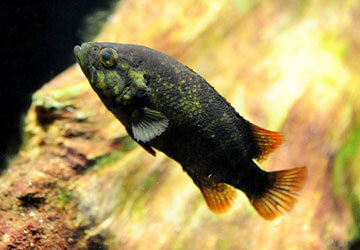
For the protection of Kyoto’s beautiful nature and rare fauna
Freshwater creatures that inhabit Kyoto, which is famous for its abundant waters, can be broadly divided into the Yura River and Lake Biwa groups. As a region surrounded by water, Kyoto is truly a treasure trove of aquatic life. Creatures that live in Mizorogaike Pond and Oguraike Pond, which no longer exists, creatures that are connected to Lake Biwa, and creatures that are peculiar to Kyoto, such as the Aucha perch, fourspine sculpin, Niwaella, and the yellow pond turtle, are also on display.
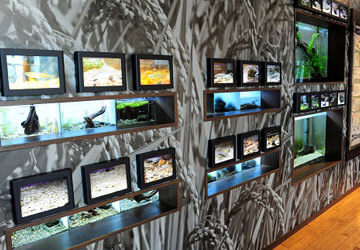
A simple presentation of the history created by the water capital
The Sanshisuimei exhibit shows the beauty of Kyoto’s nature and introduces aquatic life embraced by the city of the abundant water. Some aquatic life has become increasingly difficult to be seen in Kyoto recent years. For the purpose of ex-situ conservation and successive breeding, Kyoto Aquarium exhibits these endangered species including Japanese aucha perch and eight-barbel loach that are deeply connected to the ecosystem of Kyoto. As the information base of Kyoto’s environmental conservation, we will continue to introduce various aquatic life.
Look closely
Creatures that we all know well and feel a familiarity with, such as the Japanese eel and members of the medaka (Japanese rice fish) family, are actually declining in number. In an area that is famous for its natural scenic beauty, there are many discoveries and opportunities to think about the environment these creatures live in. Please take your time and look closely at each and every one of the pools and tanks.
Creatures encountered in this area
Ayumodoki (kissing loach), yellow pond turtle, Japanese eel, predaceous diving beetles, freshwater crab, etc.
- Rest rooms
- Elevator
- Cafe
- Accessible Rest Rooms
- Shop
- Nursing Rooms
- Locker Rooms

the River of
Kyoto
the River of Kyoto

There, right before your eyes, is world’s largest amphibian, the giant salamander.
The giant salamander is a Special Natural Monument of Japan. Described as a living fossil and believed to be one of the world’s largest amphibians, there are many mysteries surrounding the ecology of this extremely rare animal. Kyoto Aquarium has a large-scale exhibit area with a realistic display of the giant salamander’s ecology in the rivers of Kyoto.

See the whole of the Yura River, from upstream to downstream, right here!
The Yura River’s upstream, midstream, and downstream ecosystems have all been expressed in a single pool. Char and landlocked masu salmon swim in the upstream section, striped shiner and Japanese minnow in the midstream section, and carp and other fish in the downstream section. Enjoy the creatures that live in the Yura River and the changes of the seasons.
Look closely
The giant salamander is a nocturnal creature, so lies still during the day. However, if you pay close attention, you might be lucky to spy its slow and measured motion as it moves to a different location or swims up to the surface to breathe.
Creatures encountered in this area
Giant salamanders, char, landlocked masu salmon, Japanese minnow, carp, etc.

Fur seal
Fur seal

A pool that gives the illusion of swimming with fur seals
This horseshoe-shaped pool is the perfect size and height for small children. The space may feel a little cramped for adults with its low ceiling, but it is a delightful space for children, like being in a hideout. When entering the viewing area, visitors will experience the strange sensation that they are actually swimming with the fur seals. This exciting sensation is bound to pique your curiosity.

See the endearing sight of the fur seals sleeping in unique poses on the rocks.
From above the pool, visitors can see the fur seals lying on rocks and logs, basking in the sun and looking very relaxed, from a close distance. They will be so close that you will be able to see their big, bright eyes and every strand of their soft fur.
Look closely
The fur seals that live at Kyoto Aquarium have some truly unique and interesting poses when they sleep. Some of them curl up in a ball, others stretch their bodies back, and others balance precariously on logs. Check out their unique, endearing poses.
Creatures encountered in this area
South American fur seals

Seal
Seal

Get right up close to their unique expressions
An even more eye-catching sight is the large, tubular pool. This pool is actually connected to a larger tank under the floor, and the spotted seals are able to come and go freely between the two. When the seals pop up into the tubular pool, it looks just like they are flying through the air.

When they pop their faces up, you might even make eye contact.
From the deck, visitors can enjoy the unique expressions of the earless seals as they peep up from the surface of the water. If you are lucky, you might be able to gaze into the depths of their cut, round eyes.
Look closely
At certain times, visitors can also observe the earless seals being fed. Their expressions as they gaze up at the staff, begging for their food, are even cuter than usual.
Creatures encountered in this area
Spotted seal

the Sea of Kyoto
the Sea of Kyoto

Experience the mysterious atmosphere of Kyoto Aquarium’s largest pool
The magnificent sight of many different varieties of aquatic life swimming gracefully around the huge pool, filled with about 500 tons of artificial seawater that recreates Kyoto’s sea, is a breathtaking one. The huge “Sea of Kyoto” pool has about 50 varieties of aquatic life living in it, for example Bulgyhead wrasse, members of the stingray and shark families and so on. Since the creatures seen in the sea of Kyoto are changing due to the climate change, we are regularly reviewing the variety of fish in the tank.

Meet the creatures that are part of Kyoto’s culinary culture
Amadai, or tilefish, are also referred to as guji and are considered a delicacy in Kyoto cuisine. Visitors can observe up close the ecology of red tilefish, with their beautiful, bright pink bodies, as they swim around the pool and mark their own territories where they live.
Look closely
The huge “Sea of Kyoto” pool has about 50 varieties of aquatic life living in it.
Draw right up close to the pool to see what kind of creatures you can find, or stand away from the pool and be soothed by the overall sight of the pool.
Creatures encountered in this area
members of the stingray and shark families, red sea bream, Bulgyhead wrasse etc.

Penguin
Penguin

A star of the aquarium that moves leisurely on land and dynamically in the water
Most people think of penguins as living in cold climates like Antarctica, but the cape penguin actually lives in the warmer climes of southern Africa.
The land part of the penguin exhibit is undulated, making it difficult for the penguins in the water to climb the hills. This is, in fact, a deliberate design feature intended to facilitate the penguins’ development. Penguins use the power of the waves to propel themselves onto shore. The sight of the penguins displaying their wild behavior is not to be missed.

Making nesting holes to aid the penguins’ love life.
When breeding season arrives, Kyoto Aquarium makes nesting holes for the penguins. These holes actually play a very important role in making the penguins’ love bloom. It is primarily the job of the male penguin to make the nest. They make a magnificent nest and then they propose to the female. So they can present their mate with a bigger nest, the males collect pebbles and other materials from all over and build their nests quickly and efficiently.
Look closely
You can see what’s happening in the water from the 1st floor, and what’s happening on the hill from the 2nd floor. The gap between their toddling walk on land and the dynamic way they plunge through the water is irresistible.
Creatures encountered in this area
Cape Penguin

Jellyfish Wonders
Jellyfish Wonders

About 30 different species and 5,000 Jellyfish are exhibited.
Drifting through the water, staying on the bottom of the sea, poisonous…, Jellyfish that are different and unique in the characters, sizes and colors are exhibited in the various aquariums.

The GURURI aquarium, with a 360-degree Jellyfish drifting panorama
Passing under the arch of water tank, you will encounter a mysterious scenery of the full of moon jellyfish wandering in the water. Surrounded by the 360-degree aquarium, you will feel the impression of floating amongst a sea of jellyfish.

Kyoto Jellyfish Science Club
Welcome to our open-spaced laboratory that lively shows jellyfish breeding and research by the aquarium staff. You will closely observe how they attentively treat jellyfish every day.

Dolphin Stadium
Dolphin Stadium
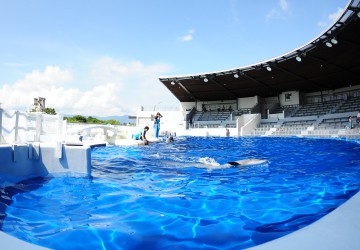
See the dolphins swimming leisurely at the stadium with views of the ancient capital
Feel the breath of the common bottlenose dolphins up close and watch their dynamic movement as they swim leisurely around. If you listen closely, you might even hear the dolphins calling out to each other.
You may see various scenes like the dolphins enjoying their meals and playing while they interactively communicate with the trainer.

Natural scenery that changes with the seasons
The Dolphin Stadium is set against the backdrop of wide open, 180º panoramic views that change with the seasons. Appreciate the beautiful natural scenery that only Kyoto can offer - the cherry blossoms in spring, the new green leaves in summer, the colorful leaves of autumn, and the snow-covered landscape in winter.
Look closely
Common bottlenose dolphins are very curious creatures. If you approach the side of the pool, sometimes, they will show interest and come up to you.
Creatures encountered in this area
bottlenose dolphins

Communication Hall
Communication Hall
Information base about Kyoto Aquarium
We exhibit coral lives permanetly, Garden eels, Anemone fish, and so on. We are also transmitting information about Kyoto Aquarium, for example, the "STAFF STATION", which is introducing our aquatic lives by aquarium keeper with full of LOVE, and reporting "AQTION!"- the Kyoto Aquarium's action to realize a sustainable society. In addition, you can enjoy various workshops.


Colorful creatures living in the warm sea.
You will closely observe patterns, colors, and other characteristics of the colorful warm sea life, such as Garden eels swaying their bodies and 6 different kinds of Anemone fish that are seen in Japan.

the Beauty
of Nature
the Beauty of Nature

For the protection of Kyoto’s beautiful nature and rare fauna
Freshwater creatures that inhabit Kyoto, which is famous for its abundant waters, can be broadly divided into the Yura River and Lake Biwa groups. As a region surrounded by water, Kyoto is truly a treasure trove of aquatic life. Creatures that live in Mizorogaike Pond and Oguraike Pond, which no longer exists, creatures that are connected to Lake Biwa, and creatures that are peculiar to Kyoto, such as the Aucha perch, fourspine sculpin, Niwaella, and the yellow pond turtle, are also on display.

A simple presentation of the history created by the water capital
The Sanshisuimei exhibit shows the beauty of Kyoto’s nature and introduces aquatic life embraced by the city of the abundant water. Some aquatic life has become increasingly difficult to be seen in Kyoto recent years. For the purpose of ex-situ conservation and successive breeding, Kyoto Aquarium exhibits these endangered species including Japanese aucha perch and eight-barbel loach that are deeply connected to the ecosystem of Kyoto. As the information base of Kyoto’s environmental conservation, we will continue to introduce various aquatic life.
Look closely
Creatures that we all know well and feel a familiarity with, such as the Japanese eel and members of the medaka (Japanese rice fish) family, are actually declining in number. In an area that is famous for its natural scenic beauty, there are many discoveries and opportunities to think about the environment these creatures live in. Please take your time and look closely at each and every one of the pools and tanks.
Creatures encountered in this area
Ayumodoki (kissing loach), yellow pond turtle, Japanese eel, predaceous diving beetles, freshwater crab, etc.

the Countryside
of Kyoto
the Countryside of Kyoto

A rice paddy in the middle of an aquarium!? Experience first hand the connection between humans and living creatures on a natural stage
The Kyoto Satoyama area, which recreates the traditional rural scenery of Kyoto, grows rice, Kujo onions, Shogoin turnips, and other traditional Kyoto vegetables, depending on the season.
This outdoor area has such an abundance of natural scenery that you will forget you are so close to the big city. On fine days, it is the perfect spot for a stroll.

Experience the connections between living creatures, humans, and nature
When the water level in the canals increases and the rice paddies are flooded with water, the fish that use that water enter the rice paddies via the canals and lay their eggs. Feel that connection between people and living creatures.
Look closely
Different insects and birds also visit the Kyoto Satoyama Area in the different seasons. You can expect the unexpected in this outdoor area.

